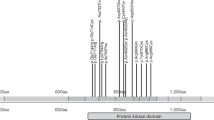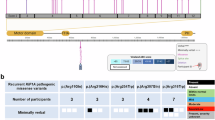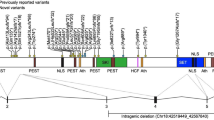Abstract
Recurrent deletions of a ~600-kb region of 16p11.2 have been associated with a highly penetrant form of childhood apraxia of speech (CAS). Yet prior findings have been based on a small, potentially biased sample using retrospectively collected data. We examine the prevalence of CAS in a larger cohort of individuals with 16p11.2 deletion using a prospectively designed assessment battery. The broader speech and language phenotype associated with carrying this deletion was also examined. 55 participants with 16p11.2 deletion (47 children, 8 adults) underwent deep phenotyping to test for the presence of CAS and other speech and language diagnoses. Standardized tests of oral motor functioning, speech production, language, and non-verbal IQ were conducted. The majority of children (77%) and half of adults (50%) met criteria for CAS. Other speech outcomes were observed including articulation or phonological errors (i.e., phonetic and cognitive-linguistic errors, respectively), dysarthria (i.e., neuromuscular speech disorder), minimal verbal output, and even typical speech in some. Receptive and expressive language impairment was present in 73% and 70% of children, respectively. Co-occurring neurodevelopmental conditions (e.g., autism) and non-verbal IQ did not correlate with the presence of CAS. Findings indicate that CAS is highly prevalent in children with 16p11.2 deletion with symptoms persisting into adulthood for many. Yet CAS occurs in the context of a broader speech and language profile and other neurobehavioral deficits. Further research will elucidate specific genetic and neural pathways leading to speech and language deficits in individuals with 16p11.2 deletions, resulting in more targeted speech therapies addressing etiological pathways.
Similar content being viewed by others
Log in or create a free account to read this content
Gain free access to this article, as well as selected content from this journal and more on nature.com
or
References
Bijlsma E, Gijsbers A, Schuurs-Hoeijmakers J, et al. Extending the phenotype of recurrent rearrangements of 16p11.2: deletions in mentally retarded patients without autism and in normal individuals. Eur J Med Genet. 2009;52:77–87.
Fedorenko E, Morgan A, Murray E, et al. A highly penetrant form of childhood apraxia of speech due to deletion of 16p11.2. Eur J Hum Genet. 2016;24:302–6.
Rosenfeld J, Coppinger J, Bejjani B, et al. Speech delays and behavioral problems are the predominant features in individuals with developmental delays and 16p11.2 microdeletions and microduplications. J Neurodev Disord. 2010;2:26–38.
Shinawi M, Liu P, Kang SHL, et al. Recurrent reciprocal 16p11.2 rearrangements associated with global developmental delay, behavioural problems, dysmorphism, epilepsy, and abnormal head size. J Med Genet. 2010;47:332–41.
Hanson E, Bernier R, Porche K, et al. The cognitive and behavioral phenotype of the 16p11.2 deletion in a clinically ascertained population. Biol Psychiatry. 2015;77:785–93.
Laffin JJ, Raca G, Jackson CA, Strand EA, Jakielski KJ, Shriberg LD. Novel candidate genes and regions for childhood apraxia of speech identified by array comparative genomic hybridization. Genet Med. 2012;14:928–36.
Newbury DF, Mari F, Akha ES, et al. Dual copy number variants involving 16p11 and 6q22 in a case of childhood apraxia of speech and pervasive developmental disorder. Eur J Hum Genet, 2013;21:361–5.
Raca G, Baas BS, Kirmani S, et al. Childhood apraxia of speech (CAS) in two patients with 16p11.2 microdeletion syndrome. Eur J Hum Genet. 2013;21:455–9.
American Speech-Language-Hearing Association (ASHA). Childhood apraxia of speech [technical report]. ASHA, 2007; ww.asha.org/policy.
Shriberg LD, Aram DM, Kwiatkowski J. Developmental apraxia of speech: I. Descriptive and theoretical perspectives. J Speech Lang Hear Res. 1997;40:273–85.
Steinman KJ, Spence SJ, Ramocki MB, et al. 16p11. 2 deletion and duplication: characterizing neurologic phenotypes in a large clinically ascertained cohort. Am J Med Genet Part A. 2016;170:2943–55.
Bohland JW, Guenther FH. An fMRI investigation of syllable sequence production. Neuroimage. 2006;32:821–41.
Basilakos A, Smith K, Fillmore P, Fridriksson J, Fedorenko E. Functional characterization of the human speech articulation network. Cereb Cortex. 2017; 1–15. https://doi.org/10.1093/cercor/bhx100.
Fernandez B, Roberts W, Chung B, et al. Phenotypic spectrum associated with de novo and inherited deletions and duplications at 16p11.2 in individuals ascertained for diagnosis of autism spectrum disorder. J Med Genet. 2010;47:195–203.
Marshall CR, Noor A, Vincent JB, et al. Structural variation of chromosomes in autism spectrum disorder. Am J Hum Genet. 2008;82:477–88.
Morgan A, Gunther T. Clinical management of articulation impairment in children. In: Dodd B, Morgan A, (eds). Intervention Case Studies of Child Speech Impairment. London: J&R Press; 2017.
Dodd B. Clinical management of phonological impairment in children. In: Dodd B, Morgan A, (eds). Intervention Case Studies of Child Speech Impairment. London: J&R Press; 2017.
Morgan A, Murray E. Clinical management of motor speech disorders. In: Dodd B, Morgan A, (eds). Intervention Case Studies of Child Speech Impairment.. London: J&R Press; 2017.
Goldman R, Fristoe M. Goldman-Fristoe Test of Articulation-2. Minneapolis: Pearson; 2000.
Dodd B, Hua Z, Crosbie S, Holm A, Ozanne A. Diagnostic Evaluation of Articulation and Phonology. London: Psychological Corporation; 2002.
Holm A, Farrier F, Dodd B. Phonological awareness, reading accuracy and spelling ability of children with inconsistent phonological disorder. Int J Lang Commun Disord. 2008;43:300–22.
Morgan A, Eecen KT, Pezic A, et al. Who to refer for speech therapy at 4 years of age versus who to watch and wait. J Pediatr. 2017;185:200–4.
Murray E, McCabe P, Ballard KJ. A systematic review of treatment outcomes for children with childhood apraxia of speech. Am J Speech Lang Pathol. 2014;23:486–504.
Murray E, McCabe P, Heard R, Ballard KJ. Differential diagnosis of children with suspected childhood apraxia of speech. J Speech Lang Hear Res. 2015;58:43–60.
Gozzard H, Baker E, McCabe P. Requests for clarification and children’s speech responses: changing “pasghetti” to “spaghetti. Child Lang Teach Ther. 2008;24:249–63.
Shriberg LD, Kwiatkowski J. Phonological disorders III: a procedure for assessing severity of involvement. J Speech Hear Disord. 1982;47:256–70.
Hayden D, Square P. Verbal Motor Production Assessment for Children. Psychological Corporation: San Antonio; 1999.
McCauley RJ, Strand EA. A review of standardized tests of nonverbal oral and speech motor performance in children. Am J Speech Lang Pathol. 2008;17:81–91.
Robbins J, Klee T. Clinical assessment of oropharyngeal motor development in young children. J Speech Hear Disord. 1987;52:271–7.
Enderby P, Palmer R. Frenchay Dysarthria Assessment-2. Pro-Ed: Austin; 2008.
Wiig EH, Secord WA, Semel E. Clinical Evaluation of Language Fundamentals Preschool-2: Australian Standardised Edition. Sydney: Harcourt Assessment; 2006.
Semel E, Wiig EH, Secord WA. Clinical Evaluation of Language Fundamentals-4: Australian Standardised Edition. Sydney: Pearson; 2006.
Zimmerman IL, Steiner VG, Pond RE. Preschool Language Scales-5: Australian and New Zealand Language Adapted Edition. Sydney: Pearson; 2011.
Wiig EH, Semel E, Secord WA. Clinical Evaluation of Language Fundamentals-5. San Antonio: Pearson; 2013.
Dunn LM, Dunn DM. Peabody Picture Vocabulary Test-4. Minneapolis: Pearson; 2007.
Bishop D. Test for Reception of Grammar-2. London: Harcourt Assessment; 2003.
Wagner R, Torgesen J, Rashotte C, Pearson NA. Comprehensive Test of Phonological Processing-2. Pro-Ed: Austin; 2013.
Wilkinson GS, Robertson GJ. Wide Range Achievement Test-4. Lutz: Psychological Assessment Resources; 2006.
Wechsler D. Wechsler Abbreviated Scale of Intelligence-2. Minneapolis: Pearson; 2011.
Kaufman AS, Kaufman NL. Kaufman Brief Intelligence Test-2. Minneapolis: Pearson; 2004.
Morgan AT, Vogel AP Intervention for childhood apraxia of speech. Cochrane Database of Systematic Reviews 2008, Issue 3. Art. No.: CD006278. https://doi.org/10.1002/14651858.CD006278.pub2.
White SM, Morgan A, Da Costa A, et al. The phenotype of Floating–Harbor syndrome in 10 patients. Am J Med Genet Part A. 2010;152:821–9.
Morgan AT, Mei C, Da Costa A, et al. Speech and language in a genotyped cohort of individuals with Kabuki syndrome. Am J Med Genet Part A. 2015;167:1483–92.
Trouton A, Spinath FM, Plomin R. Twins early development study (TEDS): a multivariate, longitudinal genetic investigation of language and cognition, cognition and behavior problems in childhood. Twin Res. 2002;5:444–8.
Lewis BA, Freebairn LA, Hansen AJ, Iyengar SK, Taylor G. School-age follow-up of children with childhood apraxia of speech. Lang Speech Hear Serv Sch. 2004;35:122–40.
Shriberg LD, Lohmeier HL, Strand EA, Jakielski KJ. Encoding, memory, and transcoding deficits in childhood apraxia of speech. Clin Linguist Phon. 2012;26:445–82.
Hippolyte L, Maillard AM, Rodriguez-Herreros B, et al. The number of genomic copies at the 16p11.2 locus modulates language, verbal memory, and inhibition. Biol Psychiatry. 2016;80:129–39.
Berman JI, Chudnovskaya D, Blaskey L, et al. Abnormal auditory and language pathways in children with 16p11.2 deletion. Neuroimage Clin. 2015;9:50–7.
Girirajan S, Rosenfeld JA, Cooper GM, et al. A recurrent 16p12.1 microdeletion supports a two-hit model for severe developmental delay. Nat Genet. 2010;42:203–9.
Brisset S, Capri Y, Briand-Suleau A, et al. Inherited 1q21.1q21.2 duplication and 16p11.2 deletion: a two-hit case with more severe clinical manifestations. Eur J Hum Genet. 2015;58:497–501.
Deriziotis P, Fisher SE. Speech and language: translating the genome. Trends Genet. 2017;33:641.
Acknowledgements
We thank the children and their families who participated. This study was supported by the Simons Foundation Variations in Individuals Project and the following grants from the National Health and Medical Research Council (NHMRC): Practitioner Fellowship awarded to A.M. (#1105008) and a Centre of Research Excellence in Speech and Language NeurobioloGy (SLANG) awarded to A.M. and S.E.F. (#1116976). S.E.F. is also supported by the Max Planck Society. E.F. and C.H. were funded by a grant from the Simons Foundation to the Simons Center for the Social Brain at MIT. This work was also supported by the Victorian Government’s Operational Infrastructure Support Programme.
Author information
Authors and Affiliations
Corresponding author
Ethics declarations
Conflict of interest
The authors declare that they have no conflict of interest.
Electronic supplementary material
Rights and permissions
About this article
Cite this article
Mei, C., Fedorenko, E., Amor, D.J. et al. Deep phenotyping of speech and language skills in individuals with 16p11.2 deletion. Eur J Hum Genet 26, 676–686 (2018). https://doi.org/10.1038/s41431-018-0102-x
Received:
Revised:
Accepted:
Published:
Issue date:
DOI: https://doi.org/10.1038/s41431-018-0102-x
This article is cited by
-
Deciphering the genetic basis of developmental language disorder in children without intellectual disability, autism or apraxia of speech
Molecular Autism (2025)
-
Developmental milestones and cognitive trajectories in school-aged children with 16p11.2 deletion
Journal of Neurodevelopmental Disorders (2025)
-
Understanding speech and language in KIF1A-associated neurological disorder
European Journal of Human Genetics (2025)
-
Neurocognitive profiles of 22q11.2 and 16p11.2 deletions and duplications
Molecular Psychiatry (2025)
-
Genetic architecture of childhood speech disorder: a review
Molecular Psychiatry (2024)



